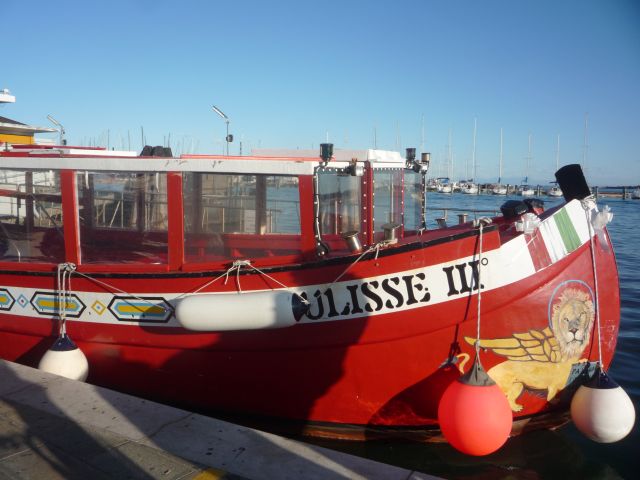Chioggia, lagoon of Venice, Pellestrina, Ca’ Roman
The Venitian lagoon is spectacular. It has a lot to show and to tell.
We participated in a tour in the South part of the Lagoon starting from Chioggia, with a “bragozzo“, typical boat of the lagoon.
We participated in a tour in the South part of the Lagoon starting from Chioggia, with a “bragozzo“, typical boat of the lagoon.

Chioggia (Southern part of the lagoon of Venice)
The departure is from Chioggia which is the largest urban center of the lagoon, after Venice. It is developed on the design of a fish.
Corso del Popolo is the street of production activities and services. At the end of the street there is Piazzetta Vigo, characterized by a marble column of the XII that holds a lion of St. Mark. From here you can embark to reach the nearby islands (Ca’ Roman, Pellestrina) and the southern lagoon.
Corso del Popolo is the street of production activities and services. At the end of the street there is Piazzetta Vigo, characterized by a marble column of the XII that holds a lion of St. Mark. From here you can embark to reach the nearby islands (Ca’ Roman, Pellestrina) and the southern lagoon.


We embark on the “bragozzo” and we leave for Valle Millecampi and its “Cason”.
We approach also in the Valle Zappa area, and cason Zappa can be seen in the distance. We were lucky: it happened to be a beautiful day, and you could see perfectly the Euganean Hills and the Dolomites.
We approach also in the Valle Zappa area, and cason Zappa can be seen in the distance. We were lucky: it happened to be a beautiful day, and you could see perfectly the Euganean Hills and the Dolomites.



Pellestrina (southern part of the Venetina lagoon )
After observing the lagoon, the birds, and the view, we headed towards Pellestrina.
The island is traditionally inhabited by fishermen in the small towns of San Pietro in Volta and Pellestrina. These stretch out on the lagoon edge, while at the sea they oppose the “murazzi” (dam built in 1774-82 of about 11 km on a project by Vincenzo Coronelli).
In Pellestrina, time seems to have stopped. It is characterized by colorful houses all overlooking the lagoon, vegetable gardens, flower gardens, a couple of restaurants to enjoy fish, a quiet promenade, and a stretch of sandy beaches with crystal clear water.
To enjoy the island, it is ideal to go around on foot or by bike.
The island is traditionally inhabited by fishermen in the small towns of San Pietro in Volta and Pellestrina. These stretch out on the lagoon edge, while at the sea they oppose the “murazzi” (dam built in 1774-82 of about 11 km on a project by Vincenzo Coronelli).
In Pellestrina, time seems to have stopped. It is characterized by colorful houses all overlooking the lagoon, vegetable gardens, flower gardens, a couple of restaurants to enjoy fish, a quiet promenade, and a stretch of sandy beaches with crystal clear water.
To enjoy the island, it is ideal to go around on foot or by bike.



Walking in Pellestrina we met an agency (Ape Tour) that rents old bikes once used for transportation of fruit and vegetables. Very special 😉

Oasi Ca’ Roman, southern part of the lagoon of Venice
Then we reached the Oasis Ca’ Roman.
Here a wild beach awaits you, surrounded by the dunes that separate it from a dense forest where many protected species of birds live.
Cà Roman preserves, thanks to its relative isolation, one of the most intact dunal environments of all the upper Adriatic and boasts, despite its small size, an extraordinary wealth of fauna: it is located, in fact, on one of the most important migratory routes in Italy and many species of birds use it in autumn and spring to rest and feed before resuming their journey.
Here a wild beach awaits you, surrounded by the dunes that separate it from a dense forest where many protected species of birds live.
Cà Roman preserves, thanks to its relative isolation, one of the most intact dunal environments of all the upper Adriatic and boasts, despite its small size, an extraordinary wealth of fauna: it is located, in fact, on one of the most important migratory routes in Italy and many species of birds use it in autumn and spring to rest and feed before resuming their journey.


How to reach Chioggia, Pellestrina and Ca’ Roman
Chioggia can be reached via the Romea 309 state road. It is recommended to park in the large parking lot of the Silos.
To reach Pellestrina and Ca ‘Roman, from Piazzatta Vigo you can find the public ACTV line (possibility of transporting bicycles, but you have to check on the spot); or thare is “Bragosso Ulisse” that organizes private tours and also makes round-trip bicycle transport at a rather convenient price.
In Pellestrina there are bike rentals, including the Ape Tour agency mentioned above. With the bike you can also walk all the murazzi from Ca ‘Roman to Pellestrina (and vice versa).

